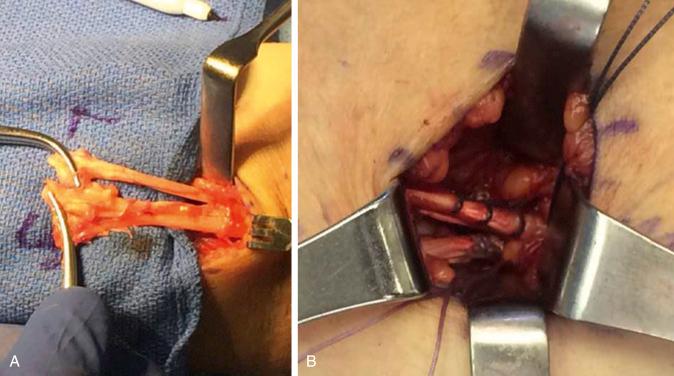Physical Address
304 North Cardinal St.
Dorchester Center, MA 02124
Distal biceps ruptures are most common among middle-aged men and occur most commonly in the dominant arm and is associated with the following risk factors: smoking, history of anabolic steroid use, chronic renal disease, elevated body mass index, and history of contralateral rupture. Mechanism of injury may be related to a hypovascular zone of the tendon, mechanical impingement in the proximal radioulnar joint, and attritional interstitial tendon weakness. The insertion of the distal biceps is often bifid in nature, with separate long and short head attachments to the radial tuberosity. Physical examination maneuvers can be helpful in diagnosing this injury. Magnetic resonance imaging is very useful in assessing injury and extent of injury preoperatively.
Keywords : Distal biceps tendon, elbow, epidemiology, long head biceps, short head biceps
Risk factors for distal biceps tendon ruptures include male gender, dominant arm, and history of contralateral distal biceps rupture, smoking, corticosteroid use, anabolic steroid use, or chronic renal disease, and increased body mass index.
Etiology is thought to be related to a hypovascular zone, mechanical impingement, and attritional interstitial tendon weakness.
Distal biceps insertion may include a common tendon or a bifid attachment of the short and long heads on the radial tuberosity.
Several different physical examination maneuvers, including the hook test, have been described to identify distal biceps tendon ruptures.
Magnetic resonance imaging (MRI) is important to evaluate for extent of injury, quality of tendons, nature of injury, and extent of retraction.
One report suggested that the incidence of distal biceps tendon ruptures was 1.2 per 100,000 patients per year ( ). A later study using the PearlDiver Technologies database, however, found an annual incidence of 2.55 per 100,000 patient-years; the average age of patients was found to be 46 years with an overwhelming (95%) male predominance ( ). Furthermore, the dominant arm is more commonly affected (86%) ( ), and a personal history of distal biceps rupture is a significant risk factor for contralateral rupture (8%) (Green et al, 2012). Additional established risk factors include smoking, anabolic steroid use, systemic corticosteroid use, chronic renal disease, and increased body mass index. Smoking specifically has been a significant risk factor and was found in one study to impart a 7.5-fold higher risk for distal biceps rupture than nonsmoking (Green et al, 2012; ).
Although the exact etiology of distal biceps rupture is not yet fully elucidated, proposed an anatomic and mechanical rationale. Through cadaveric dissections, these investigators demonstrated a 2.1-cm hypovascular zone in the distal biceps tendon occurring between vascular contributions from the brachial artery proximally and the posterior recurrent artery distally. Furthermore, they used dynamic cross-sectional computed tomography (CT) images to show that the distance between the proximal radius and ulna was 52% shorter with the forearm in full pronation than in supination. Stated another way, the distal biceps tendon occupied nearly 85% of the space between these two bones with the arm in pronation, suggesting that some form of mechanical impingement coupled with the aforementioned vascular watershed leads to progressive tendon weakness and ultimately to tendon failure ( ).
The biceps muscle acts as a secondary flexor of the elbow and the primary supinator of the forearm. It has two proximal origins, or heads: the long head, which inserts on the supraglenoid tubercle, and the short head, which meshes with the coracobrachialis tendon to form the conjoined tendon on the coracoid process. Traditionally, the biceps has been thought to have a singular insertion onto the bicipital or radial tuberosity; however, later studies (discussed here) suggest otherwise. The lacertus fibrosus (bicipital aponeurosis) emanates from the biceps muscle belly at the level of the musculotendinous junction and crosses distally and medially to insert along the subcutaneous border of the ulna.
demonstrated that, in contrast to traditional teaching, there are normal variations among distal biceps tendons that include two distinct distal long head and short head tendon insertions. Others have reported bifurcate distal biceps tendon insertions in 25% to 60% of cadaveric specimens studied ( ). Voleti et al (2016) have reported on three isolated short head biceps tendon repairs ( Fig. 30A.1 ). They found all three cases to successfully return to baseline level activity following anatomic repair of the short head component with or without the independent repair of the long head component. Other groups inserted the long head of the distal biceps tendon along the proximal aspect of the bicipital tuberosity whereas the short head inserted more distally ( ) and accounted for the majority (60%) of footprint coverage ( ). The bicipital tuberosity has been shown to be 21 to 22 mm in length and 7 to 15 mm in width ( ). , in an evaluation of 18 fresh-frozen cadaveric elbows, noted similar dimensions of the radial tuberosity as well as a ribbon-shaped distal biceps morphology.

The biceps footprint has been shown to be along the posterior/ulnar aspect of the radial tuberosity ( ) to maximize functional supination of the muscle tendon unit. examined the biomechanical contributions of the short and long head attachments in six cadaveric specimens and found that the short head contributed the greatest to supination strength in the neutral and pronated forearm, whereas the long head attachment was more efficient with the forearm supinated.
For surgical exposure purposes, it should be noted that the radial recurrent artery most commonly crosses volar to the distal biceps tendon at an average of 4 mm proximal and 15.4 mm volar to the radial tuberosity. The radial recurrent artery bifurcates nearly half the time at an average of 9 mm from its origin ( ).
Become a Clinical Tree membership for Full access and enjoy Unlimited articles
If you are a member. Log in here